
Volume 11 - Spring 2001
Aloys and All Those Stones
by Nolan Watts
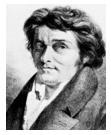 On
November 6th 1771, Aloys Senefelder (Aloysius, Johann, Nepomuk, Franz, Senefelder)
was born while his father, an actor of the Royal Theatre of Munich was playing
at Prague. Sometime after the family's return to Baveria, the young Senefelder
attended grammar school at Munich and eventually received a scholarship of 120
florins a year which enabled him to study jurisprudence at the University of
Ingolstadt.
On
November 6th 1771, Aloys Senefelder (Aloysius, Johann, Nepomuk, Franz, Senefelder)
was born while his father, an actor of the Royal Theatre of Munich was playing
at Prague. Sometime after the family's return to Baveria, the young Senefelder
attended grammar school at Munich and eventually received a scholarship of 120
florins a year which enabled him to study jurisprudence at the University of
Ingolstadt.
His father's death in 1791 forced him to abandon his studies and support his mother together with his eight brothers and sisters. Senefelder attempted to become an actor, against his dead father's wishes, but achieved greater success as a dramatic writer.
A turning point came when his printers failed to meet the deadline for the production of his play, "Mathyle von Altenstein". This prevented its presentation at the prestigious Lipzig Fair resulting in a substantial loss of income followed by crippling debts. Senefelder took a position with a printer and publisher and later purchased his own press as he was anxious to print and publish his own works. On a meagre budget, he began a series of experiments. He etched on steel, copper, and zinc, but the expense lead him finally to practice on a slab of locally quarried limestone.
One day in 1796, Senefelder's mother interrupted his work to write a laundry list for her but as there was no paper to hand he wrote it on a freshly polished stone with a greasy crayon. Rather than cleaning the stone he discovered that when chemically treated and inked, impressions could be pulled from it.
Senefelder developed a method of marking the stone with a greasy composition of soap, wax and lamp-black. The absorbent stone was then washed over with water which penetrated the surface which remained on the unmarked areas of the stone. Printing ink was then applied to the stone's surface which adhered to the greasy image while being repelled by the wet areas.
Despite being dogged by considerable financial difficulties, disappointments and continuing discouragement he remained steadfast. Senefelder accepted an offer from a music publisher, Johann Anton André. He set himself up at Offenbach and trained others in his lithographic process. Senefelder went on to make numerous improvements to his "chemical" printing process and was later awarded the gold medal by the Society of Encouragement of England, the highest medal of the Polytechnische Verein fur Baiern, the gold honorary medal of the order for Civilverdienst of the Bavarian Crown together with many other prizes. In Senefelder's latter years the king of Bavaria settled a handsome pension on Senefelder until his death in 1834.
Lithographic Stone
The stone which is used in lithographic printing is a very fine-grained, compact limestone (calcium carbonate, CaCO.). Although limestone is deposited freely all over the world, it is only in the Jura Mountains, Bavaria, that the superfine quality required for lithography is found.
Solnhofen Limestone, named after the small town of Solnhofen in the state of Bavaria, lies in the region between Nuremberg and Munich. Millions of years ago, carbonated muds have formed a type of fine-grained, flat-cleaving limestone (known as Plattenkalk in German) that has been quarried since the Stone Age for roof and floor tiles, and more recently for lithographic stone. These rocks are also famous for their fossils. Although relatively rare, fossils from the Solnhofen Limestone may show exquisite detail, and often include fragile or soft-bodied organisms that usually leave no fossils at all, or only fragmentary ones. Vertebrate and invertebrate animals, land plants, and protists (traditionally called protozoa, algae, and lower fungi) are all represented as fossils in the Solnhofen Limestone.
The Solnhofen Quarries
The Solnhofen quarries and fabrication plants are family owned and operated. Individual plants are geared to finishing a specific stone into tiles, facade panels, and dimensional pieces. At each factory, state-of-the-art, computer controlled machines cut the raw stone into shapes and forms and polish, hone, sand, roughen, striate and flame it to fit architectural and design requirements.
The age of the high density limestone and fossils varies from 100 million to 180 million years and falls into categories based on physical characteristics, colour and location of the layers within the different quarries.
Fossilstone. The top of the quarry strata is formed by thin layers of limestone ranging from 1/16" to 15" in thickness. Within these layers, deposited approximately 150 million years ago, millions of fossils, distinctive markings and mineral deposits can be found. The most common characteristic of fossilstone is the pattern of grey, fern-like dendrites on the cream-coloured surface of the stone. The thin layers of fossil stone can only be extracted by hand, using hammer and chisel, they split apart one thin layer at a time.
Beneath the thin layers of fossilstone lies even older stone, approximately 180 million years old. Deposited in layers up to six feet in thickness, this stone is extracted using hydraulic drills and compressed air. This distinctive stone is characterized by many fossils and markings. Ammonites, belemnites, marine worms, corals and sponges, as well as veins and deposits of calcite, quartz, iron oxide and pyrite.
Printing from
|
Printing from a flat surface is dependent upon the natural aversion of grease for water. The design is drawn on the grained surface of the stone with greasy inks or crayons, and the whole surface is than damped. The grained surface helps to hold the water while the ink repels it. The whole stone is then rolled up with a printing ink which sticks to the greasy drawing, but not to the wet surface of the untouched stone. |
|
Right
- The image is drawn
onto the stone in reverse for direct printing. |
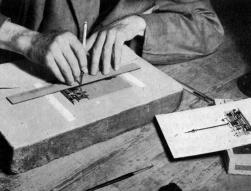 |
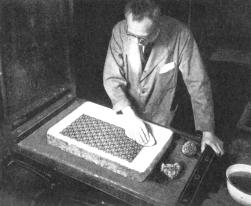 |
Left
- The image and stone is damped with water and the excess removed. |
|
Right
- An inked roller is worked
to and fro over the dampened surface. |
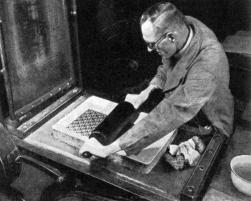 |
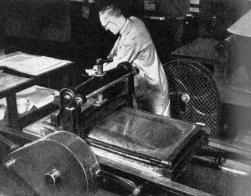 |
Left
- Paper is placed in register, the tympan closed, pressure applied with the side lever and the press bed is moved forward under the scraper. |
|
Right
- The tympan is lifted and the print
removed from the stone. |
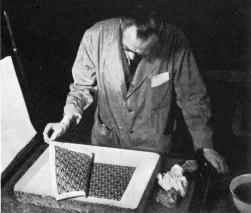 |
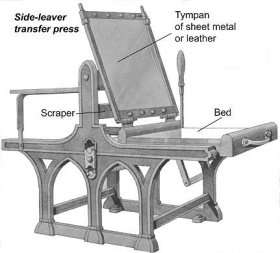 The
Rise of Lithography
The
Rise of Lithography
Lithography spread with remarkable rapidity and by 1820 it was being practised in most of the European countries. Senefelder travelled Europe, inaugurating the process in the chief cities and supplying materials and equipment. Improvements were continually being made and the scope of the process widened. A tint was added to chalk drawing in black and this led to the use of coloured inks.
As Lithographic stones were heavy, cumbersome, difficult to register, and liable to breakage, zinc plates were occasionally employed instead. Zinc was cheaper and lighter than limestone and could be curved around a cylinder, but the techniques of producing a high-quality image from it had not yet been discovered. Almost all fine lithographers, therefore, continued to use stone. However, these were minor inconveniences compared to lithography's great advantages over other processes, especially in the area of colour printing.
By the middle of the nineteenth century, colour lithography - or chromolithography, was the process of choice for a number of ambitious projects and in London between 1851 and 1853, the massive Digby Wyatt's "The Industrial Arts of the Nineteenth Century at the Great Exhibition" was produced. It contained 160 illustrations printed by chromolithography, and each one used at least seven colours. 1,300 copies were printed at a rate of about 18,000 impressions per week, for a total of 1,350,500 impressions in all. After each impression or "pull", the lithographic stone had to be cleaned and re-registered for the next sheet. 1,069 stones were required, together weighing 25 tons. The paper alone weighed 17,400 pounds. Over the next forty years, chromolithography steadily out paced its rivals until, it too was replaced. At its height, however, and in the proper hands, the process was capable of exquisite results.
Alternatives for Stone
As the stones were so cumbersome other alternatives were suggested and used by Senefelder. These included zinc and it was towards the end of the century before the trade generally accepted zinc plates. Senefelder also developed a system of spreading a solution of stone over the surface of card or paper so that this could be treated as a "plate".
For over sixty years lithographic printing was done on hand-operated, presses although Senefelder was certain that all the operations could be better carried out mechanically. The first lithographic machine was in operation by 1852. Sigls's 'fast' machine was subject to the usual scorn and derision given to pioneers. This press had a reciprocating bed to carry the stone, a cylinder with grippers for the sheet, a feed-board, damping and inking rollers. The fly wheel was turned by hand. Unfortunately, the press was rather too revolutionary for a very conservative trade.
Between 1864 and 1875 various flat-bed presses were made in Britain, France and Germany but it was difficult to find enough skilled men to work them as these presses required a great deal of work to keep them running.
The First Offset Machine
In 1875, Robert Barclay patented the process for printing onto metal rather than paper. The first offset machine put to general practical use had the usual reciprocating bed carrying the litho stone but in addition it had two cylinders, one above the other. The lower cylinder was covered with a specially prepared card on which the print was taken from the stone. The sheet of metal then passed between the two cylinders and received the impression on the underside, by transfer from the card. After many experiments the card was replaced with a rubber-covered cotton sheet, or blanket.
The reciprocating motion of the litho flat-bed machine was clumsy and required a great deal of power. In addition the rollers were comparatively noisy. The use of plates of both metals became widely used on flat-bed machines as an alternative to stone.
This technical and practical progress with thin, flexible printing surfaces paved the way for the rotary type of machine which appeared towards the end of the nineteenth century. The idea of such a machine had been conceived many years before by Senefelder but the first practical machine came from New York and the general design developed and manufactured in Great Britain.
These direct rotary machines simply retained the cylinder and the delivery apparatus of the flat-bed machine, while replacing the stone bed and ink slab by a second cylinder. This produced a smooth, quiet-running machine that virtually doubled production.
Taking care of your litho stone
You can use plate glass, marble and a number of other flat materials on which to pare leather but the major attraction of limestone is that its surface can be easily maintained.
The traditional method is to use a 'muller' and abrasive powder but these days all that's needed is waterproof abrasive paper wrapped around a smallish wooden block. Keep the stone's surface wet with water and rub until you have a smooth surface. Start with a coarse grade paper if the surface is badly scratched and finish with a fine grade.
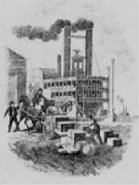 Lithograph
City
Lithograph
City
During the 19th century vast quantities of Solnhofen stone, were shipped to the United States for use in commercial lithography. At the turn of the 20th century, a town in north-central Iowa was founded because of this interest in high-quality lithographic stone. As the limestone is exposed along the Cedar River valley near the Floyd-Mitchell county line, Clement Webster, an enterprising citizen of Marble Rock established a settlement called Lithograph City. Here the limestone was quarried and marketed to compete with the more expensive, imported Bavarian stone.
The onset of the First World War curtailed the importation of Bavarian stone, and the operation at Lithograph City was expanded to meet the anticipated demand for quality stone.
By 1915, Webster's community consisted of 15 houses, a hotel, general store, blacksmith shop, timber yard, stone crushing and polishing plant, dance hall, and museum. The quarries operated for only a short period, however, and the town failed to prosper as metal engraving replaced lithographic stone in providing good quality printing at lower cost. After 1915, the town's name was changed to Devonia but later abandoned and by 1938 was reported to be completely ploughed under.
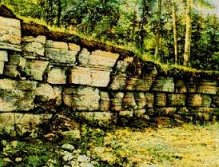 |
The
old Gable Quarry, southwest of Osage, Mitchell County, Iowa. |
Nolan Watts - Nolan has
spent the majority of his working life in the graphic arts industry. From a
background of letterpress printing and binding, he studied at both the London
and Watford Colleges of Printing. Throughout his career in the graphics industry
he has gained a breadth of knowledge and practical experience in pre-press and
press production embracing all the major printing processes.
From print management during the mid 70s, he moved into graphic design and
is a practising designer, bookbinder and founder of The Standing Press publishers
of The Craftsman's Guide series of books - www.standingpress.com.
